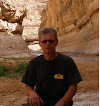Day 420
Lüderitz.
The area southwards from Lüderitz is called - The Sperrgebiet in German , "prohibited area" or by the direct the name - "Diamond Area 1." The length of the area from north to south is 320 km and the width - up to 100 miles. And all together this area is 26,000 km2, that is larger than half of Estonia. Diamond mining started around here in 1908, when during the railway construction work the first diamond was found.
Mining it's not the most appropriate word, as diamonds were picked just from the ground in the beginning. Mining is still in progress, each year the machines raise about 33 million tons of sand.
Some facts about diamonds of Namibia. About 3,200 people are employed in the area, and in 2010 about 1.2 million carats were mined, which is 1.5% of the world production. It makes an annual production of 240 kg per year (1 carat is 0.2 grams). Diamonds are even on the Coat of Arms of Namibia.

I became interested in the area to see by myself but that was not allowed. No chance.
Since 2009 some part of the area is so open to tourists, that one-day-trips with pre-registration are organized by local tour organizer with his vehicle. By the pre -registration a copy of the passport was made and I was told that after a few days the permit will be ready. And so it was, as promised. And while entering the area by the barrier it was announced that we are allowed to take pictures of everything, no restrictions. And that was really a pleasant surprise!

The first view.

And the first buildings

By turns - stone desert and sand dunes.


Mitsubishi was our vehicle there.


Sandy descends.

The remains of a railway in the sand

The mining began in 1860 when The Pomona Mining Company was founded. The search for copper, lead and silver ended with no result. Later it became clear that during the searches the diamonds were shoveled away to find other mineral from deeper ground.
1910 diamonds were picked directly from the ground, the area was so rich, that in the years of 1912-1914 about more than 200 kg of diamonds were found here.

This is what the area after mining looks like.

The sand-sifting devices are fairly well preserved in dry climates.


The sand is everywhere, only electric post is still visible here.


But indoors one can only guess that there's something more than the sand there.





Pomona village. There were times when more than 1,000 inhabitants lived there, there was a school, church, hotel and bowling alley.

A couple of hundred meters away - the cemetery


Further towards south.
Another important attraction in the region is Bogenfels Arch Rock, 60 meters high. The sight is more powerful, and the arc is greater - compared to the previously found photos from internet. 60 meters is, after all, as a 20-story building.

To claim up the top of the arc is prohibited. Quite understandable – no fences for safety.

And could not get straight under the arch either.

A view towards north.


The trip back was more sandy. The term "more sand" here in Namibia and in Africa as a whole acquires quite a different meaning.

The dune is moving slowly, and burying all it has occupied. The local guide said that only the river, flowing water could stop the process.


Like snowdrifts in the middle of the road. With a few wheel tracks. Only nobody drives over snowdrifts this way.



No comments:
Post a Comment